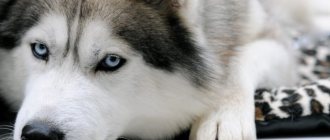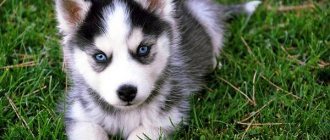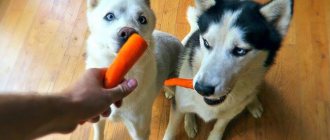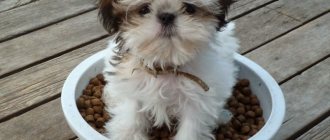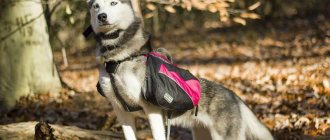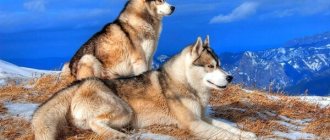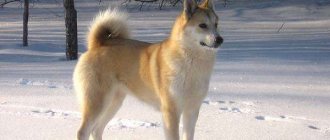Husky is an amazing dog. Many, having seen the expressive look of blue eyes in the photo and read about their good-natured character, dream of having such a pet. But representatives of this breed are not suitable for everyone. They require special conditions of detention, good upbringing and serious physical activity. After all, this is a working, sled dog, whose homeland is Siberia and the Far North. But despite this, huskies are a popular breed. People like not only her unusual appearance. Dog lovers are attracted by their unpretentiousness, friendliness, devotion and intelligence.
- pros
- Head
- Feeding rules
- What is the price
History of the Siberian Husky breed
The Siberian Husky is a dog that has been living next to humans for many centuries. It was bred by the indigenous inhabitants of the Russian Far North. The Chukchi desperately needed a dog that could cover long distances and transport people and cargo from seasonal hunting grounds to camps. Harsh climatic conditions had a decisive influence on both the formation of the animal’s structure and its character.
Husky with eyes of different colors (Heterochromia)
The spread of the breed beyond its centuries-old habitat began actively in the 20th century. The husky's endurance, ability to work harmoniously in a harness for a long time and good speed were appreciated on the American continent. Alaskan mushers increasingly began to purchase these dogs to participate in sled dog racing. The greatest fame was gained by Leonard Seppala's team, led by the legendary Togo, which did not give up the palm for several years in a row. But this musher and his dogs entered the history of mankind primarily because it was his Togo, leading a team, who covered a huge part of the path of the famous dog relay of 1925, delivering anti-diphtheria serum to Nome. A small town in Alaska, cut off from the world by miles of snowy desert, is overwhelmed by an epidemic of a deadly disease. It was not possible to get to it quickly and safely by conventional means: unfavorable weather and natural conditions were not suitable for air or land transportation. And then people turned to the faithful huskies for help. The sled relay covered more than a thousand kilometers in a record five days, and the city's population was saved. The best dogs, led by Togo, covered 146 km - the maximum distance. The dogs walked eighty kilometers on the ice of Norton Bay in forty-degree frost in a snowstorm. Such a feat became possible only thanks to the instinct, courage and endurance of the leader of the pack.
The last team in this relay were the dogs of Gunnar Kaasen, led by Balto, who got all the glory. In memory of these events, grateful people erected a monument to this dog in New York. Statues of Togo and Balto greet guests at the entrance to ClevelandMetroparksZoo, and when visiting the museum in the small Alaskan town of Wasilla, you can see Togo's embalmed body. To commemorate that incredible relay, Alaska hosts an annual multi-day sled dog race.
Husky puppy
Further development of the breed took place on the American continent, since in the 30s in the USSR the selection of sled dogs was considered unpromising.
In the USA, for a long time, special attention was paid to the sports component. The crossing of Siberian huskies with native sled dogs of Alaska led to the emergence of mixed breeds, which became much more successful than huskies in racing competitions, although they did not receive recognition from international organizations - the mixed breeds turned out to be very diverse.
A new direction in the history of the breed - exhibition - began from the moment when E. Seely and L. Demidoff first presented a bright black and white dog with blue eyes to the judges. It was since the 70s of the last century that huskies increasingly appeared as a domestic companion dog, quite suitable even for keeping in an apartment.
The return of the breed to its historical homeland, Russia, occurred in the 90s. The first dogs were imported from Belgium and the Czech Republic in 1995, and after five years the number of purebred puppies reached one and a half hundred.
Dalmatian
The spotted Dalmatian closes the TOP 15. The animal is distinguished by its unique coloring and running performance. The spotted dog's movement speed reaches 38 km/h. In addition, it is distinguished by endurance and is able to cover distances of up to 10,000 meters.
Dalmatian
Peculiarities:
- coat color;
- devotion;
- endurance;
According to the results of the TOP 15, the fastest dog is the Greyhound, which can accelerate to 68 km/h. Such indicators allow it to rank among the fastest mammals. The remaining representatives of the canine family show no less outstanding results. For example, a master of sports in running is not able to overtake the participants in the rating.
Siberian Husky breed standard
Today, huskies are divided into three groups - sledding, sporting (racing) and exhibition.
The official breed standard describes a sled dog. To a greater extent, British-bred huskies fall under these criteria.
Dimensions
Siberian Huskies in their element
The Siberian Husky is a medium-sized animal. The height of a dog at the withers is from 54 to 60 cm, of a female – from 51 to 56 cm. The weight of dogs is 21-28 kg and 16-23 kg, respectively. Excessive height is grounds for disqualification. The husky's weight is proportional to his height, the length of the body when viewed from the side is slightly greater than the height at the withers (extension index 110-120).
Head
The skull is small in size, rounded at the back of the head and tapering evenly towards the eyes. The bridge of the nose is smooth, the stop is clearly defined. The muzzle is of medium length, with almost the same distance from the nose to the stop and from it to the back of the head. It tapers evenly to the nose, which should be neither sharp nor square.
Huskies are characterized by a lively and interested, even with a certain amount of mischief, expression on their muzzle.
The disadvantages include:
- a sharply defined and massive head;
- the presence of an unclear transition from the muzzle to the forehead;
- black nose for gray, red and black huskies, and brown for brown dogs;
- muzzle too narrow or too wide.
Eyes
Set slightly obliquely at an average distance from each other, almond-shaped. The color of the iris is brown or blue, mosaic-colored or heterochromic options are allowed.
Disadvantages: eyes that are too close and too slanted.
Husky eyes
Ears
Husky ears are located high on the head at a short distance from each other. They stand firmly, with slightly rounded tips pointing straight up. The ears are medium-sized and triangular in shape.
Disadvantages – the ears are too large (in relation to the size of the head), the tips are directed not upward, but to the sides.
Teeth
A scissor bite is required; any deviation is a fault.
Neck
Husky muzzle
Medium length, raised on a standing animal. When moving, it bends so that the husky's head is slightly forward.
Disadvantages - too thick, as well as excessively long or short neck.
Frame
The chest is strong and deep (huskies have a fairly large heart), the ribs are widely spaced. The back is strong, with a level line from the shoulder blades to the croup. The lumbar region is elastic and tucked.
Disadvantages - too wide chest with barrel-shaped ribs, sagging back, sloping topline from the shoulder blades to the croup.
Tail
In a calm state, the husky's tail is slightly lowered and is located slightly below the line of the back. When the dog is interested or excited, it bends upward in a sickle shape, but curls into a ring, does not roll over its back or curl to the side. The coat has approximately the same length, which is why the husky's tail resembles a round fox's.
Disadvantages - too low or, on the contrary, too high, tightly curled tail.
Limbs
Brown Husky
The front ones are straight and parallel, located at a moderate distance from each other. The elbows are pressed to the body, turning neither in nor out. The bone is not heavy, but strong.
The hindquarters are parallel, moderately spaced. The knee joints are mobile, hock, have clearly defined angles and are located close to the ground.
Vestigial digits on both the front and hind legs must be removed.
Disadvantages: cow-like hindquarters, elbows turned outward, heavy large bone.
Paws
Husky paws are medium in size, oval, but not elongated. Well furred between the pads of the toes. The pads are thick-skinned. When the dog is at rest, its paws do not turn to the sides.
Disadvantages: clumsy or, conversely, too small paws, flat toes.
Wool
The husky's coat is of medium length, which, creating the effect of good furring, does not interfere with viewing the lines of the body. The undercoat is soft and dense. The outer coats are straight and smooth, but in no case coarse or erect.
Disadvantages: shaggy, hard coat.
Color ranges from pure white to black. There are white mask-like markings on the head, characteristic only of huskies.
Photos of adult huskies
Russian canine
Eighth place in the TOP 15 is occupied by the Russian dog. This breed is immediately associated with hunting. The muscular body, elongated nose and long legs are designed for chasing prey. The running speed is 55 km/h.
Russian canine
The first description of the breed was documented 400 years ago. The animal has not changed since then. The slender and graceful body reaches a height of 85 cm. The dog’s coat is long, so it has a memorable appearance and tolerates frost well.
A loyal and intelligent animal has one feature that is worth considering before buying a puppy. The Russian Canine is impatient with pain. Physical impact can lead to aggression. Therefore, it is not recommended to keep the animal in the same room with children, who, through carelessness, may cause pain to the animal.
Character of the Siberian Husky
Friendliness, liveliness of mind and calm disposition are the main properties of the Siberian Husky. But, speaking about these wonderful dogs, I would not like to limit myself to such a short list.
Ready for the New Year!
The ancestors of modern animals, who faithfully served man for many centuries in the harsh conditions of the Far North, passed on to their descendants all the variety of distinctive character traits and behavior that so attract connoisseurs of this breed today.
Huskies, like true sled dogs, are very active and need good, constant exercise.
Representatives of this breed are not suitable for hunting enthusiasts, despite the presence of a fairly strong instinct. For the Siberian Husky, such hunting is one of the ways of subsistence, and it will not share the prey (the dogs were fed only in winter; the rest of the time the team was grazing).
These northern dogs are pack animals, which has led to almost complete elimination of the instinct to protect their own territory, so such pets are completely unsuitable for the role of a guard. The lack of aggression towards humans, even strangers, also does not allow these dogs to be classified as guard dogs. Attempts to embitter the dog can only lead to permanent mental disorders of the animal. Nature has endowed these amazing dogs with well-developed intelligence and the ability to make independent and often extraordinary decisions. Hence the difficulties that arise during training, when certain commands require a template algorithm of actions from the husky. The use of representatives of the breed as service animals is not practiced.
The Siberian Husky is a companion dog. She is perfect for a large family; she will tenderly and reverently love all members of the household, although she recognizes only one as the leader and master. The attitude of these animals towards children deserves special attention. It is difficult to find a more gentle, attentive and affectionate friend for a child. Suffice it to recall that the Eskimos even used huskies to warm newly born babies.
One of the unusual character traits for dogs is the animal's tendency to run away. A door latch or cap hook will not become an obstacle - understanding the principle of their operation for a pet is a matter of a few days. Digging a hole under a fence, and if necessary, overcoming a high barrier is also not a problem. No one claims that your dog will systematically engage in such pranks, but you should still not forget about this feature of the husky.
Siberian Huskies in harness
Saluki
The second place is occupied by the Persian greyhound, or as it is also called - Saluki. She is not much inferior to the leader. The running speed is 67 km/h. At the same time, the animal is famous for its endurance and is able to run for 3-5 hours.
Saluki
The breed has existed for 5 thousand years. Salukis were kept in ancient Egypt. Archaeological artifacts bear an image of this four-legged pet. At home they get along with other pets. They love children and are friendly. In addition, she is clean and not whimsical.
Education and training
When it comes to raising and training a Siberian Husky, it is important to consider that these dogs are working dogs by nature, but not service dogs. Experts consider representatives of the breed to be good and easy to train animals. But they will obey only a recognized leader and owner - you must become an indisputable authority for the pet.
Raising a puppy should be based on two main principles - rigor and fairness. The carrot and stick policy is unacceptable. An overly gentle attitude will spoil the baby and he will “sit on your head”; cruelty will embitter the animal, which will definitely take revenge on you if necessary.
You can start training and training your dog from the age of three months. The Siberian Husky is very intelligent, and if you fail to interest him, it will be difficult to achieve results. And not because the animal does not understand you - no, he is simply not interested. The greatest effect is achieved by the training process in the form of a game. These dogs are very sensitive to the manner in which commands are given, so correct intonation is very important. You must speak calmly, confidently and clearly. Although at the same time, many owners of dogs of this breed note that huskies respond better to requests than to orders. In any case, every owner is looking for his own way to the heart and mind of his pet.
Raising any dog is impossible without a system of rewards and punishments. There are several husky misbehaviors that should be stopped immediately:
- aggressive behavior towards the owner;
- unreasonable hostility towards other dogs;
- actions that could harm the animal itself.
The best method of punishment for a Siberian Husky is to demonstrate its strength and advantage. To do this, simply grab the animal by the withers, press it to the floor and hold it until the dog stops resisting and becomes quiet. Beating as a method of education is unacceptable.
It's easier with incentives. Always praise your dog for every correct action. If you are working with a puppy, praise can be reinforced with a piece of treat. The intonation should be different from the tone in which you give commands, but do not show unnecessary emotions - huskies cannot stand high, shrill intonations.
Dog habits
Habits can be physiological, age-related or psychological:
- So, for example, during the period of changing teeth, you can notice your pet’s desire to try everything “to the teeth.”
- Another physiological bad habit is swallowing large pieces when receiving food . This is due to the fact that the animal tends to slow down its metabolism in order to stay full longer.
- Age-related habits include eating feces, stones, and branches. During the period of active growth, the puppy needs many useful microelements. With their deficiency, the pet tries the surrounding objects, getting used to their consumption.
- Another unpleasant feature is the tendency of male dogs to mark corners. This is due to the desire to show that the territory belongs to a certain pet. Simple education will help avoid this.
- Huskies love to dig holes. They can make digs or simply destroy flowerbeds for fun. They like to wallow in the ground and snow, and dig through garbage. During puppyhood, dogs are considered especially destructive.
- Despite the fact that the breed is classified as “quiet” (non-barking), one of the problems is howling. Most often, dogs whine out of boredom or to attract attention. This can be attributed to psychological habits.
Where to start training a puppy
1. Recognizing your own nickname.
The methods are quite simple. Call his name when you call your pet to a bowl of food, and after the baby wakes up, gently stroke him, saying his name. The results will not keep you waiting. Dad with two puppies
2. Husky, as a pack dog, needs a leader, so from the first hours of being in your home, let it understand who is in charge. Moreover, be careful - even when communicating with members of your family, you must behave as an unquestioned authority, and the puppy must see this. The husky is very smart and will immediately sense if you give in to “slack” in relations with other members of the pack, and the dog perceives all household members this way.
3. Execution of the simplest commands: “Nearby!” and “Come to me!” achieved by the traditional method - with the help of tasty treats and praise.
Many owners are concerned about what to do in cases where the puppy reacts violently to strangers coming into the house: it behaves annoyingly, gets underfoot, begs for food. There is only one answer - ignore it. Don’t stroke, don’t admire (the husky is just waiting for this), but simply don’t notice. The method works flawlessly. The dog, realizing that no one is interested in him, will very soon leave for his place.
Among the general recommendations for raising and training a Siberian Husky, the following can be highlighted:
- do not forbid your pet to communicate with other dogs;
- do not pick up the dog, especially holding it belly first;
- do not tire your husky by performing the same command many times in a row;
- respect your friend and treat him fairly.
Behavior on the street
The dogs are very sociable, they love the company of their relatives, the puppies strive to sniff and play with everyone they meet. Males often run away when they smell a female. The owner must accustom the pet to the fact that it is always more interesting to be with a person. To do this, while playing with other animals, the owner needs to periodically call the puppy, give him treats, and concentrate his attention on communicating with the family.
In general, outdoor animals are active, playful and curious . They will not phlegmatically stroll around their owner; they need to study everything and get to know everyone. Huskies can chase cats and pigeons, although otherwise they react calmly to objects: they rarely bark and do not run after bicycles or cars.
During the winter season, pets love to play in the snow and even often sleep in snowdrifts. In the summer, they won’t refuse to swim in a pond or pool.
Care and maintenance
When purchasing a husky puppy, you must remember that these Siberians simply cannot stay in a limited space for a long time. Any attempt to turn your pet into a “couch” dog is doomed to failure. Movement, active games, good physical activity, long walks - these are the elements of these magnificent animals.
Husky on a leash
In order for the energy of a dog, especially one living in an apartment, to be directed in the right direction, experts of the breed recommend loading the Siberian Husky to the fullest. Otherwise, the comfort of your home may be seriously damaged. One of the options may be to keep the dog in a cage. Accustomed to this state of affairs from an early age, the husky will react to this quite calmly. Another thing is that for a loving owner, the sight of a friend sitting behind bars will not evoke positive emotions at all, so the best way out still seems to be to “load” the pet to such an extent that he simply does not have the strength for domestic pranks.
Maintenance in a country house also has its own characteristics. Remember that huskies are dogs from harsh regions, and being on the street is not a burden for them. Many owners note that even in severe frosts, animals rest and sleep in the snow, and not in a booth - the spirit of the Arctic reminds of itself.
Be sure to provide your pet with a spacious enclosure. Just don’t use chain-link for this: in a matter of days, the Siberian Husky will turn it into hanging rags. For fencing, use wire at least half a millimeter thick. It is better to lay the floor with natural stone, because these dogs are great experts in digging and will not fail to demonstrate their talent in this matter. If you think that an enclosure is unnecessary, make sure that the fence of your area is a reliable barrier in the way of the husky in his desire to explore and travel far.
The best thing is to find time to take your dog for much-needed walks.
What do you need to purchase before bringing your pet into your home? First of all, these are a couple of bowls for water and food, special “chew” toys, and a rug on which your friend will rest. A little later you will need to buy equipment such as a collar, leash and muzzle. A halter can also come in handy - with its help, even a child can control a Siberian Husky.
Border Collie
Initially, the breed is considered a herding breed, so at the genetic level the ability to move quickly and control everything is inherent. Running speed varies within 48 km/h.
Border Collie
Due to its good-natured nature, the border collie has gained popularity. The animal is easy to train. In one day, a dog can learn up to three commands.
Peculiarities:
- unpretentiousness;
- friendly attitude towards children;
- devotion;
- learning ability
What and how to feed huskies
Until the age of two months, the puppy is fed 6 times a day, up to 4 months - five, up to six months - four, then - three times a day. From ten months onwards, it will be enough for a Siberian Husky to eat twice, and an adult animal (over one and a half years old), depending on physical activity, eats once or twice a day.
Most experts agree that it is better to feed your four-legged friend dry food and special canned food. These must be premium and super-premium products. Cheap food contains a high content of starch, which is not very beneficial for these northern dogs.
You can immediately see who was visiting grandma
Until the animal reaches 10 months of age, “puppy” food will be sufficient for normal development; for adult huskies, balanced food for breeds with high physical activity should be used.
Even when using the highest quality feed mixtures, breeders recommend carefully monitoring the dog’s condition in order to make timely adjustments to the menu if necessary.
Organizing a husky’s proper nutrition with natural products is somewhat more difficult. Up to 60% of the diet should be meat (raw or slightly scalded). The best choice - beef, rabbit and turkey - are possible, it is better not to mess with chicken due to the high risk of allergic reactions, pork and lamb should be completely excluded. Eggs, or rather boiled and raw egg yolks, can be added to porridge a couple of times a week; vegetables, with the exception of potatoes, are also healthy. It is better to give dairy products only in their sour versions. Don't forget to add a little vegetable oil and fish oil to the food.
No matter how varied you feed your Siberian Husky, you cannot do without vitamin supplements. Your veterinarian will tell you about their correct use.
Pet hygiene comes down mainly to coat care, especially during shedding, as well as monitoring the condition of the teeth. To keep them white and smooth, clean the stone and plaque in a timely manner. This can be done both at home and in the clinic.
But huskies do not need bathing. Their fur is capable of self-cleaning, and this dog does not have a “dog spirit”. It is water procedures that provoke the appearance of an unpleasant odor, which can lead to disruption of the fat balance of the skin and coat.
Proper care and maintenance is the key to your friend’s well-being and longevity.
Notable fugitives
Huskies have a well-earned reputation as runaways who will wander off into parts unknown if given the chance, and many of these beautiful dogs have been injured or lost as a result of such runaways. Huskies can jump over fences, crawl under fences, break chains, slip out of collars, and perform other tricks that would make Houdini proud to escape their captivity.
The subject of appeals to the prosecutor's office are violations of rights by employers
By entering a lucid dream, you can control your future: we learn to do this
The head of Rospotrebnadzor told where it is better to spend the May holidays
Health and disease of the Siberian Husky
As a true child of high northern latitudes, the Siberian Husky is distinguished by good health.
However, this does not mean that the owner should not monitor the condition of his pet. When purchasing a puppy, study the pedigree of its parents and check if there were any genetically transmitted diseases in its family. For dogs of this breed, most often these may be diabetes mellitus or problems with the thyroid gland, some eye diseases (glaucoma, corneal dystrophy, cataracts), and hip dysplasia. Sometimes Siberian Huskies suffer from epilepsy. This disease cannot be completely cured, but proper care will reduce the number of attacks. Timely and complete vaccination and careful monitoring of the dog’s condition will help avoid the occurrence of most health-related problems.
It is recommended to periodically examine the animal’s ears, eyes and teeth, and monitor the condition of its fur. Don't ignore your husky's gait. Lameness can be the result of either muscle damage or incipient problems with the musculoskeletal system.
Monitor your dog's weight. Both obesity and wasting are equally harmful.
Timely deworming is very important for the Siberian Husky, especially considering the tendency of dogs of this breed to eat feces (any attempts should be strictly suppressed).
Keeping in mind the northern origin, during summer walks try to choose the coolest and shady places.
If you experience any signs of discomfort, you should immediately contact your veterinarian.
With good care and proper maintenance, the life expectancy of a husky can be more than 15 years.
Huskies love sausages
Hungarian Vizsla – 60 km/h (record – 64 km/h)
The Hungarian Cops are very different in appearance from the other finalists. Vizslas are very muscular, strongly built dogs with a wide, proportional skull. Unpretentious to care for, but very sociable animals are loved by many people. Vizslas are one of the 10 fastest dogs: their speed can exceed 60 km/h!
How to choose a puppy
The main rule is that you can only buy a baby in specialized nurseries or from well-known breeders. This will give you much more guarantee that the grown animal will fully comply with breed standards and be in good health. Buying a husky puppy online or on the market is completely out of the question. Even if they really offer you a purebred baby, how can you check in what conditions the dog was kept, what the puppy, as well as its parents, were fed? No one can guarantee you correct and timely vaccination. And these are all the components of your pet’s future health.
Purchasing a Husky puppy from a breeder or kennel has other benefits. Firstly, you get the opportunity to directly communicate with all the puppies of the litter, evaluate their character, temperament and intelligence. Secondly, gain a lot of important information about the behavioral characteristics of animals, their diet, and habits. An experienced and responsible breeder will definitely answer all your questions, ask why you chose a Siberian Husky, and give practical advice on care and maintenance. Thirdly, a puppy from a nursery or from a recognized breeder must have all the necessary accompanying documents, from a pedigree to a veterinary record with data on vaccinations and deworming.
A Siberian Husky puppy can be taken home at approximately two months of age. Try to meet your baby as often as possible, walk and play with him. Many breeders recommend taking an older animal - the dog already has some skills and is more disciplined, and the new owner will simply have a little less educational tasks at first.
It will also be useful to know that each husky raised in a kennel has its own brand. It is usually placed on the inside of the dog's ear or on the dog's belly.
Podenco Ibicenco
This is a Spanish hunting dog that is capable of chasing prey at a speed of 40 km/h. Long legs, a muscular neck and an athletic build indicate noble origin.
Podenco Ibicenco
Podenco Ibicenco is the embodiment of endless energy. They have a keen sense of smell, hearing and vision. They need to implement hunting skills that are inherent at the genetic level.
Photos of Siberian Husky puppies
Afghan Hound – 50-60 km/h
Afghan hounds are one of the most beautiful hounds. Their long silky coat, intelligent, expressive eyes and wonderful character make many people fall in love with them. Afghan hounds are very playful and social pets, but they will not be able to take a dominant position among other animals. Beautiful dogs are agile and dexterous hunters, excellent jumpers and runners (their average speed is not less than 50 km/h, but sometimes exceeds 60 km/h).
How much does a Siberian Husky cost?
There are several factors that influence the cost of husky puppies.
This includes the presence of a pedigree, the individual qualities of the baby (appearance, physical fitness, gender), and the status of the parents. It is clear that the cubs of champion dogs - in the case of huskies, not only for exhibitions, but also for sports competitions - will cost much more than the babies of ordinary parents. If you just want to have a friend at home and don’t bother with a show career, your choice is a pet-class puppy. It will cost 20-25 thousand rubles. Most likely, it will be sold without a pedigree, but will that stop you?
Breed-class dogs already cost from 30 thousand rubles. They have all the necessary documents and are quite suitable for breeding work. Some minor deviations from the breed standard are possible.
The most expensive are show class puppies. Such animals fully comply with official standards, have no flaws and are born husky champions. The price for a dog of this class can be more than 60,000 rubles. Buying a baby without the advice and help of an experienced breed expert will be very problematic.
When planning to buy a Siberian Husky, do not chase the low price. On the contrary, such a proposal should alert you. Most likely, ordinary deception or dishonesty is taking place. A husky puppy, taking into account the costs the breeder incurs when breeding this breed, simply cannot be cheap.
Deerhound
In sixth place is the Scottish Greyhound, better known as the Deerhound. This is a hardy dog that is used for hunting deer. The running speed reaches 56 km/h.
Deerhound
The animal is large with developed muscles and long hair. The breed appeared in the 16th century. The animal does not have guard inclinations, so they were kept for hunting. Representatives of the breed participate in dog races and take prizes.
Azawakh – 60 km/h
The Azawakh is an ancient breed that originated in Africa. This greyhound is perfectly adapted to harsh climates (arid and hot) and can retain strength for a long time to track and pursue prey. Azawakhs have a very thin, bony body covered with very short red hair. Despite their external degeneration, African greyhounds develop considerable speed - about 60 km/h!
No. 8. German Shepherd – 48 km per hour
The German Shepherd is the second most popular breed in the world. Originally used for herding sheep. Today, the shepherd dog is used in police and military work, as a guide for the disabled, for detecting drugs and explosives, and in search and rescue work. Loyal, caring, friendly dog is ideal for a family, easy to train and very intelligent.
